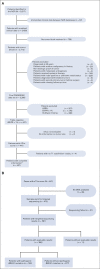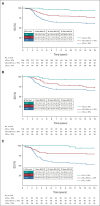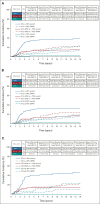Prognostic Value of Stromal Tumor-Infiltrating Lymphocytes in Young, Node-Negative, Triple-Negative Breast Cancer Patients Who Did Not Receive (neo)Adjuvant Systemic Therapy
- PMID: 35353548
- PMCID: PMC9287283
- DOI: 10.1200/JCO.21.01536
Prognostic Value of Stromal Tumor-Infiltrating Lymphocytes in Young, Node-Negative, Triple-Negative Breast Cancer Patients Who Did Not Receive (neo)Adjuvant Systemic Therapy
Abstract
Purpose: Triple-negative breast cancer (TNBC) is considered aggressive, and therefore, virtually all young patients with TNBC receive (neo)adjuvant chemotherapy. Increased stromal tumor-infiltrating lymphocytes (sTILs) have been associated with a favorable prognosis in TNBC. However, whether this association holds for patients who are node-negative (N0), young (< 40 years), and chemotherapy-naïve, and thus can be used for chemotherapy de-escalation strategies, is unknown.
Methods: We selected all patients with N0 TNBC diagnosed between 1989 and 2000 from a Dutch population-based registry. Patients were age < 40 years at diagnosis and had not received (neo)adjuvant systemic therapy, as was standard practice at the time. Formalin-fixed paraffin-embedded blocks were retrieved (PALGA: Dutch Pathology Registry), and a pathology review including sTILs was performed. Patients were categorized according to sTILs (< 30%, 30%-75%, and ≥ 75%). Multivariable Cox regression was performed for overall survival, with or without sTILs as a covariate. Cumulative incidence of distant metastasis or death was analyzed in a competing risk model, with second primary tumors as competing risk.
Results: sTILs were scored for 441 patients. High sTILs (≥ 75%; 21%) translated into an excellent prognosis with a 15-year cumulative incidence of a distant metastasis or death of only 2.1% (95% CI, 0 to 5.0), whereas low sTILs (< 30%; 52%) had an unfavorable prognosis with a 15-year cumulative incidence of a distant metastasis or death of 38.4% (32.1 to 44.6). In addition, every 10% increment of sTILs decreased the risk of death by 19% (adjusted hazard ratio: 0.81; 95% CI, 0.76 to 0.87), which are an independent predictor adding prognostic information to standard clinicopathologic variables (χ2 = 46.7, P < .001).
Conclusion: Chemotherapy-naïve, young patients with N0 TNBC with high sTILs (≥ 75%) have an excellent long-term prognosis. Therefore, sTILs should be considered for prospective clinical trials investigating (neo)adjuvant chemotherapy de-escalation strategies.
Conflict of interest statement
Prognostic Value of Stromal Tumor-Infiltrating Lymphocytes in Young, Node-Negative, Triple-Negative Breast Cancer Patients Who Did Not Receive (neo)Adjuvant Systemic Therapy
The following represents disclosure information provided by authors of this manuscript. All relationships are considered compensated unless otherwise noted. Relationships are self-held unless noted. I = Immediate Family Member, Inst = My Institution. Relationships may not relate to the subject matter of this manuscript. For more information about ASCO's conflict of interest policy, please refer to
Open Payments is a public database containing information reported by companies about payments made to US-licensed physicians (
Figures



References
-
- Menning S, de Ruiter MB, Kieffer JM, et al. : Cognitive impairment in a subset of breast cancer patients after systemic therapy-results from a longitudinal study. J Pain Symptom Manage 52:560-569 e1, 2016 - PubMed
Publication types
MeSH terms
Substances
LinkOut - more resources
Full Text Sources
Other Literature Sources

